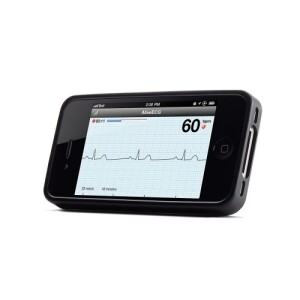by
Carol Ko, Staff Writer | May 13, 2013
From the May 2013 issue of HealthCare Business News magazine
Will sleeker, cheaper mobile devices someday change the way doctors diagnose patients? The jury’s still out, though this rapidly-growing market is already attracting considerable attention. Take the much buzzed-about AliveCor iPhone ECG heart monitor, for example. The device, which fits over the back of your iPhone, uses a biosensor to detect patient electrocardiogram readings. It was approved by the FDA in December, cleared for prescription in March and is sold for $199 on the company website.
Another svelte smartphone-centered device, Scanadu Scout, uses biosensors to measure parameters such as pulse transit time, heart rate, electrical heart activity, body temperature, heart rate variability and blood oxygenation. The device, roughly the size of a makeup compact, is expected to gain FDA clearance by late 2013.
Will such devices revolutionize health care as we know it? That’s the opinion of experts such as Dr. Eric Topol, a tireless proponent of consumer electronics who touts a leaner, cheaper health care system driven by smartphone technology. During his keynote speech at HIMSS in March, he shared apps for ear and eye exams that may one day take the place of hospital exams. Topol also claims that he hasn’t used a stethoscope in over two years. But he’s not alone.




Ad Statistics
Times Displayed: 44306
Times Visited: 1369 Keep biomedical devices ready to go, so care teams can be ready to care for patients. GE HealthCare’s ReadySee™ helps overcome frustrations due to lack of network and device visibility, manual troubleshooting, and downtime.
“The decreasing cost of smartphones and its widespread adoption across the globe will enable it to be the global health care portal,” says Dr. Dave Albert, founder and chief scientific officer of Alive- Cor. According to Albert, this will pave the way for a future in which patients will be able to acquire, transmit and receive feedback on their health status anywhere, anytime.
Ultimately AliveCor’s ECG monitor gets at a larger, much-discussed trend in health care: patient self-management. And indeed, the remote health management market is growing rapidly and is set to double by 2016.
But there are several looming obstacles in the way of Albert’s vision. One of them is the question of payment. Will patients pay $200 dollars out of pocket for such a device when they’re used to a $20 co-pay? And, for that matter, will doctors pay money for such a device when they could easily use stethoscopes and other equipment provided for free by hospitals?
Such thorny questions will continue to come up as old guard products built around a thirdparty reimbursement model co-exist with sleeker, cheaper products rolled out by tech companies such as AliveCor and Scanadu.
“As they said in Ghostbusters, ‘dogs and cats living together! Mass hysteria!’” Albert says.

